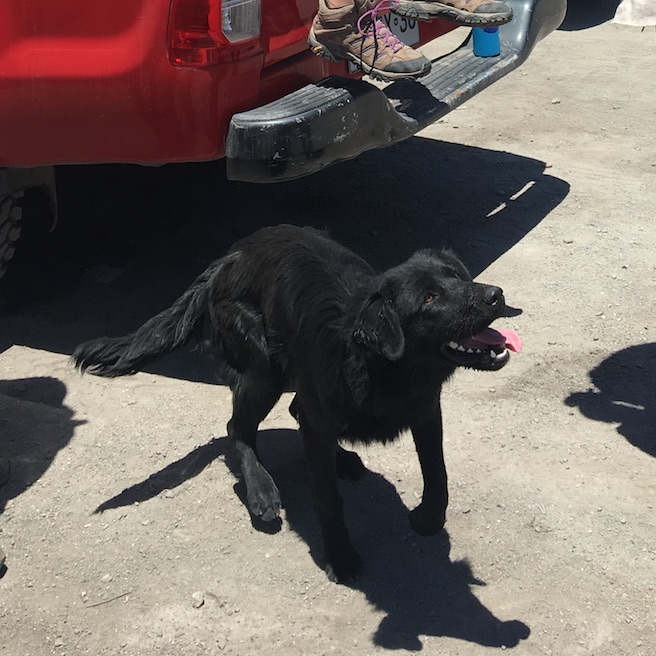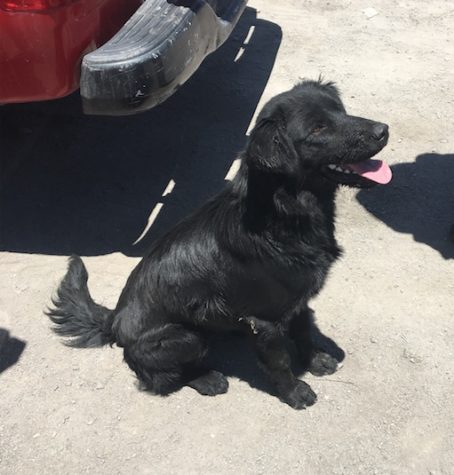
I believe in a heaven for all dogdom
where my dog waits for my arrival
waving his fan-like tail in friendship.
~ Pablo Neruda
When you land in Chile, the first thing you notice is the color of the sky. An easier thing to describe is the second thing you notice: The dogs. The country is full of them. How had I forgotten?
At the airport; on the street; in patches of shade; along medians; inside human-built, open-access doghouses erected on sidewalks and in parks; on the innumerable anonymous beaches: Look for approximately six seconds, and you will find quiltro. This word is Chilean, not Spanish, and refers to any stray mongrel dogs that take up residence someplace and are welcomed, not necessarily treated as nuisances.
The dogs are one of my favorite things about Chile. Five years ago, when I first visited the narrow country to see its newest telescope, a vaguely German-shepherd-looking dog adopted me in San Pedro de Atacama. It started out 20 paces behind me, and as I walked through town, it edged slightly closer. At its closest approach, I might as well have had it on a tight leash. It kept its ears relaxed and its head down, its tail straight: A friendly, yet businesslike posture. I was never afraid.
It followed me through the old mission, past a park, down the street past the hostels, and to the tourist marketplace where I bought a tiny stuffed vicuña and a knit wool hat. I spent 20 minutes browsing lapis lazuli, and the dog was still there when I emerged. It kept me company a while longer before loping off to some dog business at the center of town. I watched it fade from my view.
The dogs of Chile are nothing like the strays of my town, or anywhere else I have lived. Stray dogs here are often battered, lost, hungry, scared, sometimes scary. (I know this in part because I have adopted two of them.) The dogs of Chile are more like communal pets. They lounge. They are fat. They are often lazy. Even the security dogs at airport customs are all smiles and distractible wags. Have you ever seen a TSA-badged Belgian Malinois make eye contact and wag its tail at you?
I saw countless quiltros on my more recent trip. From the northern reaches to the mining town that served as my home base, these creatures were such a source of comfort. This is not only because dogs are objectively the best animals; plenty of psychological and physiological research backs up the health benefits of caring for dogs. “Joyful, joyful, joyful,” as Neruda writes, “as only dogs know how to be happy/with only the autonomy/of their shameless spirit.” Rather, like the children I saw everywhere — what is the median age of Chile, anyway? — the presence of the dogs was inherently calming.
When you are driving hundreds of miles by yourself, in a country far across the globe where you don’t speak the language very well, and where you are clearly a foreigner, and clearly female, you look for these sources of comfort. Fat, happy, friendly dogs made me feel safe. Surely, if a country treats its dogs this well, it will treat its human visitors well, too. I mean, Gandhi said so.*
Here are some of the dogs I saw: On a Sunday afternoon, a gray, vaguely terrier-esque stray ran alongside a leashed Shih Tzu on the beach boardwalk. Neither canine (nor human) was fazed in the least. On a Wednesday, a lanky tan quilto with a dark snout made its way to the basement parking garage of a supermarket, where it hung out by the escalator. People stopped to pet it on their way up to shop, or on their way back down to their cars. It wagged its tail and sat placidly, hoping, but not really begging, for a morsel of food.
At the truck stations, where mining camiones and tour buses must stop for inspections and fees, packs of dogs hung out and held court. At one stop in midday, I saw a huge white dog snoozing, stretched languidly in a quadrangle of shade. In another stop at night, a sandy-haired dog of medium heft lay at attention under a streetlamp, five steps from the guardhouse door. When I drove through a truck stop for the final time, a pack of dogs started barking and leapt at my SUV, and I braked hard out of fear I would hit them. “This is a game for them,” said my passenger, “don’t worry.” I worried anyway, but the dogs did back off when I honked the horn, and resumed lounging as soon as my wheels were clear.
Most quiltros I saw were quiet and moved deliberately, but in one town, a puppy proved the exception to this rule. She** was onyx-black but coated in a fine layer of desert grit, like I was. She was friendly. She approached our convoy as we waited for our freshly ordered empanadas. We all cooed at her, and she knew exactly how to respond. She wagged her tail and smiled that dog smile — softly panting, tongue out, lips upturned, teeth flashing ultrawhite in a signal of her youth — and she sat.

“She’s so cute,” we said. “Awww, look at her wagging her tail!” we cried. “Can we keep her? Let’s take her with us,” we told each other.
We shouldn’t touch her, said one of my traveling companions, not necessarily because she might bite, but because she was probably full of fleas. Later, in our tents, we’d regret it and curse “that f*#@ing dog,” he said, with a wry laugh. We knew he was right. Still, it took so much effort not to scratch behind her ears. I avidly wanted to touch her, to feel the grimy fur under my palm and let her know I was a friend. Instead, I tossed her a crumbly corner of my empanada.
Others in my group tossed her more pieces, and after a few bites, she curled up in the shade of our beefy, tomato-colored Toyota pickup. Then she started growling at people in the distance.
“Now she’s ours. She’s protecting us,” our flea-warner said. Another traveler pulled in to the empanada parking lot and she started barking menacingly. In less than five minutes, she had found a pack of humans, charmed them, filled her belly, found shade, and offered protection and cuteness in return. What a racket! What a smart, social creature! What an adorable display of convergent evolution! Joyful, joyful, joyful.
We finished our empanadas and licked the last of the aji off our fingers. Sniffing, she saw that we were done, and she sprang up from the shade and trotted off, another caravan to charm, another traveler to comfort. Dogs are excellent. Chilean dogs are the best.
Photo credits: The author’s desert-coated iPhone
* “The greatness of a nation and its moral progress can be judged by the way its animals are treated,” Gandhi supposedly said. I don’t know whether this quote, often used in animal-rights outreach campaigns, can really be attributed to Gandhi. I could spend some more time Googling it, but honestly it doesn’t really matter, because it’s a good line, and it’s probably true.
** I actually don’t know whether the dog was male or female, but my dog is female and also black, so I saw her face reflected in this dusty desert specimen, and the Tocopilla dog became female.
I believe in a heaven for all dogdom
I was with you till the fleas came into the picture, reminding me that many dogs are allergic to flea bites and get a miserable unbearably itchy dermatitis from them so they scratch and bite themselves raw. And then I had some more questions: Who takes these dogs to the vet for their vaccinations — at least for rabies? Who finds them and tends them when they’re not smiling cutely for treats but rather hiding somewhere because they’re ill or in pain? Who euthanizes them if they’re hit by a car and injured, but not severely enough to die outright?
Sorry, but I suspect the visible paradise entails plenty of suffering behind the scenes.